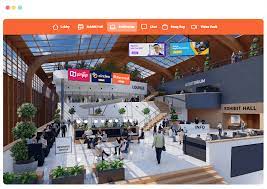The Importance of Trade Show Services for Your Business
Trade shows are crucial events for businesses to showcase their products and services to a targeted audience. To make the most out of these opportunities, investing in trade show services can significantly impact your success.
Trade show services encompass a wide range of offerings, including booth design and construction, logistics management, promotional materials, staffing, and lead generation. These services are designed to help you create a professional and engaging presence at trade shows, attracting potential customers and generating valuable leads.
One of the key benefits of utilizing trade show services is the expertise and experience they bring to the table. Professional service providers have in-depth knowledge of what works best at trade shows and can help you design a booth that stands out from the competition.
Additionally, trade show services can save you time and resources by handling all aspects of your participation in the event. From setting up your booth to coordinating shipping logistics and staffing, these services allow you to focus on engaging with attendees and growing your business.
In conclusion, investing in trade show services is a wise decision for any business looking to maximize its impact at trade shows. By leveraging the expertise and support of professional service providers, you can ensure that your presence at trade shows is both effective and memorable.
9 Essential Tips for Maximizing Your Trade Show Success
- Plan ahead and book your booth space early to secure a prime location.
- Create an eye-catching display that represents your brand effectively.
- Train your staff to engage with attendees in a friendly and knowledgeable manner.
- Offer promotional items or giveaways to attract visitors to your booth.
- Utilize technology such as interactive displays or virtual reality experiences to stand out.
- Network with other exhibitors and attendees to build relationships and explore potential partnerships.
- Follow up with leads promptly after the trade show to maximize ROI.
- Collect feedback from visitors to evaluate the effectiveness of your booth and make improvements for future shows.
- Stay organized throughout the planning process by creating a detailed timeline and checklist.
Plan ahead and book your booth space early to secure a prime location.
To maximize the effectiveness of your trade show presence, it is essential to plan ahead and book your booth space early to secure a prime location. By securing a strategic spot on the trade show floor, you can increase visibility and attract more attendees to your booth. Planning ahead also allows you to ensure that your booth design and promotional materials align with your desired location, maximizing the impact of your presence at the event.
Create an eye-catching display that represents your brand effectively.
Creating an eye-catching display that effectively represents your brand is a crucial tip when it comes to trade show services. Your booth design and visuals are the first things that attendees will notice, so it’s essential to make a strong impression that aligns with your brand identity. By incorporating your brand colors, logo, and messaging in a visually appealing way, you can attract more visitors to your booth and leave a lasting impact on them. Remember, consistency in branding across all elements of your display will help reinforce brand recognition and make your booth stand out among the competition.
Train your staff to engage with attendees in a friendly and knowledgeable manner.
Training your staff to engage with attendees in a friendly and knowledgeable manner is a crucial tip when it comes to trade show services. Your staff members are the face of your business during the event, and their ability to connect with attendees can make a significant impact on the success of your participation. By providing them with the necessary training and guidance, you can ensure that they are equipped to interact confidently, answer questions effectively, and ultimately create a positive impression that resonates with potential customers.
Offer promotional items or giveaways to attract visitors to your booth.
Offering promotional items or giveaways at your trade show booth is a smart strategy to attract visitors and create engagement. People are naturally drawn to freebies, and providing them with something tangible can leave a lasting impression of your brand. By offering promotional items that are useful, unique, or relevant to your target audience, you not only increase foot traffic to your booth but also have the opportunity to start conversations and build relationships with potential customers. Remember, the key is to offer items that will resonate with attendees and leave a positive impression of your company long after the trade show ends.
Utilize technology such as interactive displays or virtual reality experiences to stand out.
To stand out at trade shows, it is essential to leverage technology such as interactive displays or virtual reality experiences. By incorporating these innovative tools into your booth design, you can create a memorable and engaging experience for attendees. Interactive displays allow visitors to interact with your products or services in a hands-on way, while virtual reality experiences transport them to a different world, leaving a lasting impression. Embracing technology at trade shows not only sets you apart from the competition but also demonstrates your commitment to innovation and customer engagement.
Network with other exhibitors and attendees to build relationships and explore potential partnerships.
Networking with other exhibitors and attendees at trade shows is a valuable strategy to build relationships and explore potential partnerships. By engaging with industry peers, you can exchange ideas, share insights, and establish connections that may lead to collaborative opportunities in the future. Building strong relationships within the trade show community not only enhances your networking skills but also opens doors to new business prospects and growth possibilities. Embrace the power of networking at trade shows to expand your professional network and unlock the potential for mutually beneficial partnerships.
Follow up with leads promptly after the trade show to maximize ROI.
Following up with leads promptly after the trade show is crucial to maximizing your return on investment (ROI). By reaching out to potential customers while your brand is still fresh in their minds, you can capitalize on the interest generated during the event and convert leads into sales. Prompt follow-up shows your dedication and professionalism, setting a positive tone for future interactions and increasing the likelihood of closing deals. Remember, timely communication is key to nurturing relationships and turning trade show connections into valuable business opportunities.
Collect feedback from visitors to evaluate the effectiveness of your booth and make improvements for future shows.
Collecting feedback from visitors at trade shows is a valuable practice that can provide essential insights into the effectiveness of your booth. By gathering feedback on aspects such as booth design, engagement strategies, product presentation, and overall experience, you can identify strengths and areas for improvement. This feedback allows you to make informed decisions on how to enhance your booth for future shows, ensuring that you continue to attract and engage attendees effectively.
Stay organized throughout the planning process by creating a detailed timeline and checklist.
To ensure a successful trade show experience, it is essential to stay organized throughout the planning process. One effective tip is to create a detailed timeline and checklist. By outlining key milestones and tasks in advance, you can stay on track and ensure that nothing falls through the cracks. A well-structured timeline and checklist will help you manage deadlines, coordinate logistics, and allocate resources efficiently, ultimately leading to a seamless and successful trade show participation.


